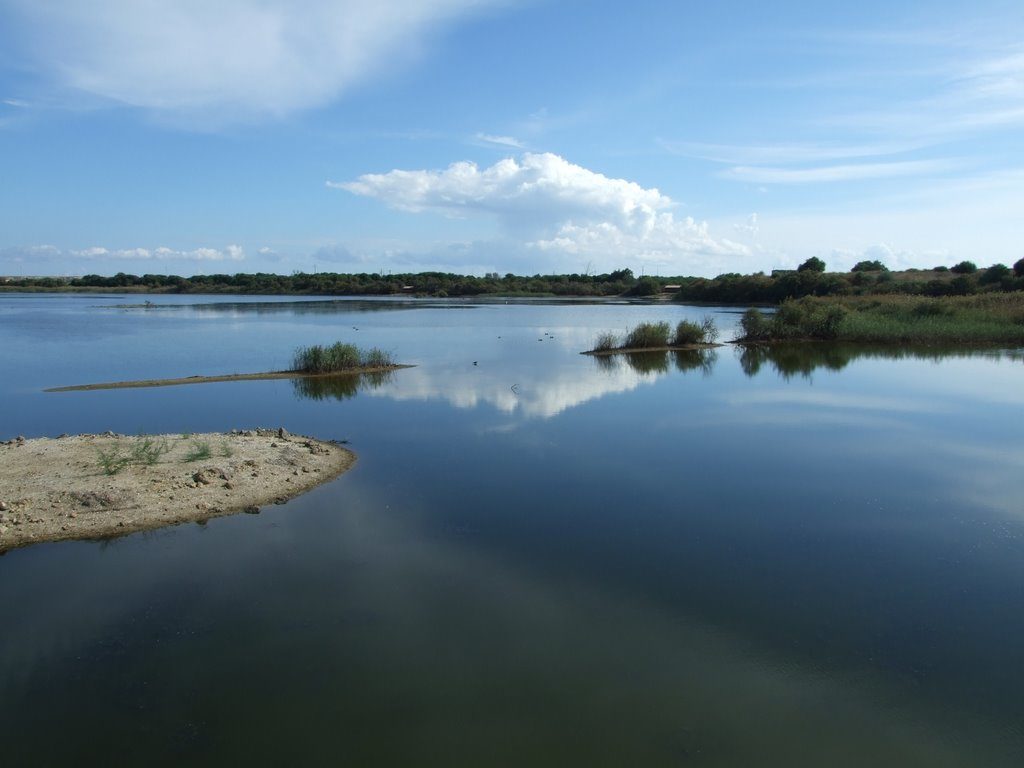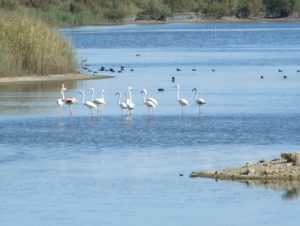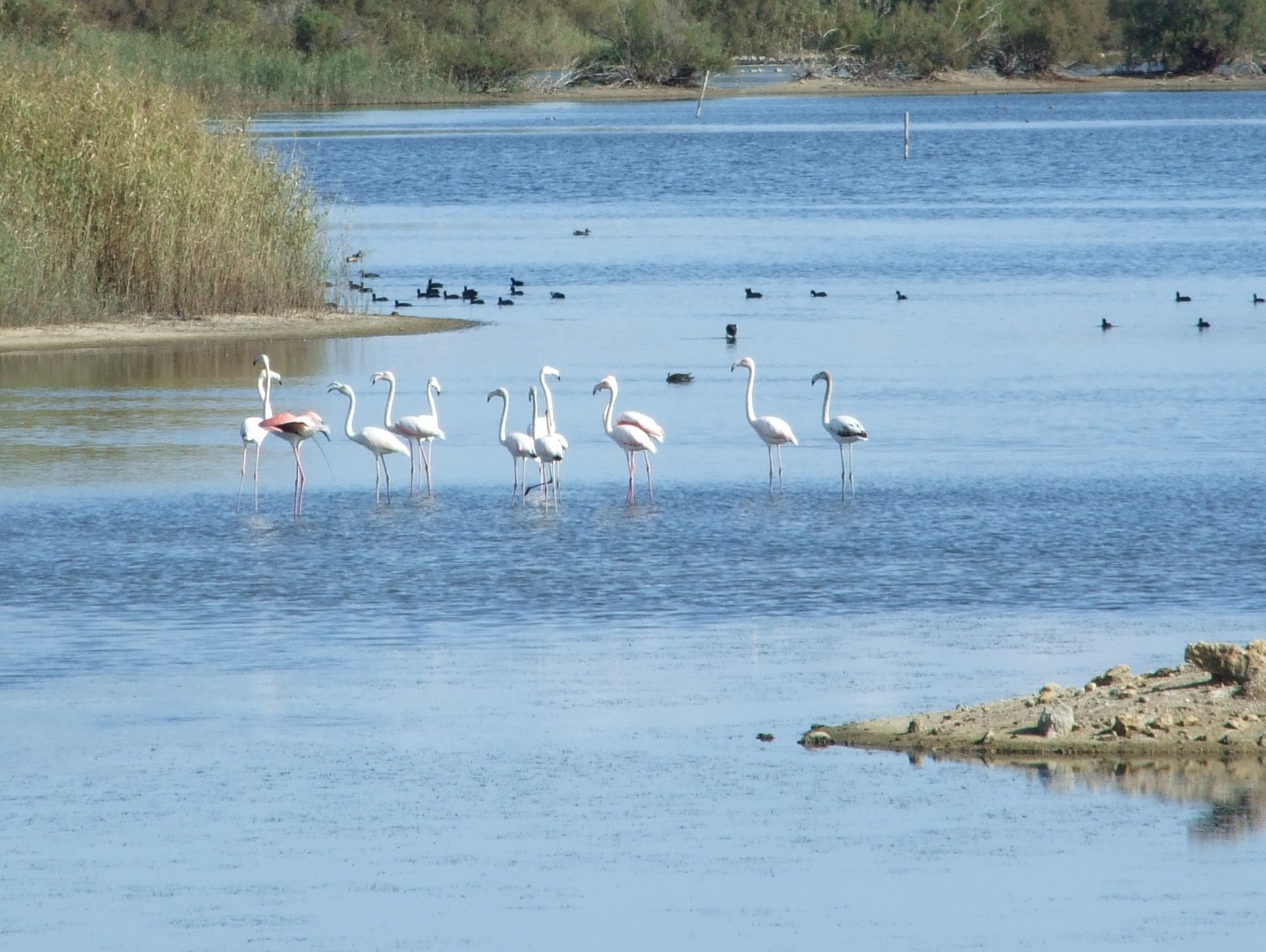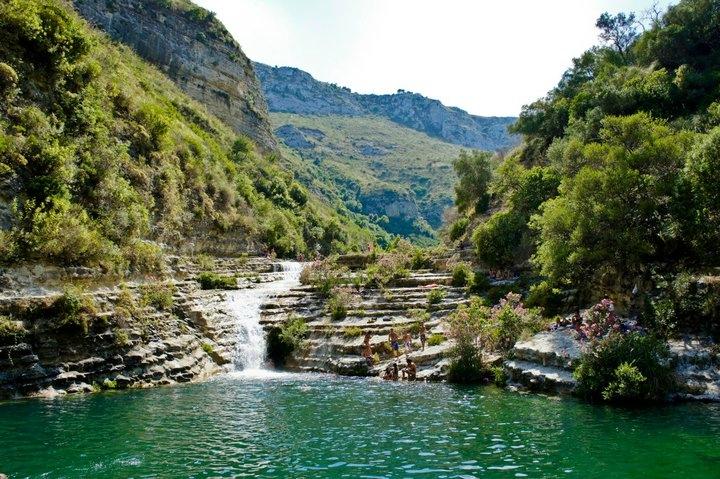The Priolo Saltpans Nature Reserve and the pink flamingos migration.
The saltpans lie within the territory of the municipality of Priolo Gargallo and protect an area of about 55 hectares, right in the middle of one of the largest petrochemical hubs in Europe. It is therefore a nature reserve that arose between the chimneys, almost as if to symbolise the rebirth of a territory heavily transformed by human intervention and its need for environmental requalification. It is also an important resting, nesting and wintering area for a large number of birds (at least 237 species recorded), almost entirely migratory. The reserve was established in December of the year 2000 with the aim of protecting the system of basins of which the salt-pan is made up and which hosts extensive Phragmiteti and Salicornieti which, together with the wetland, offer a particular shelter to the rich migratory and sedentary avifauna.
Long ago, before the birth of the industrial plant, the salt pans and the coastal dune habitat extended for several kilometres, between Priolo and Marina di Melilli, and their beauty and charm were sung by the Roman poets Virgil and Ovid, by the Athenian historian and soldier Thucydides and by the Byzantine geographer Stephen of Byzantium. In the last 10 years, the area is gradually returning to its former glory and has completely transformed its face from an industrial area to ‘Italy’s most beautiful oasis”, recognition arrived in 2008 at the competition votes “Italy’s most beautiful oasis” of the association of birdwatching EBN Italy. In fact, in the Priolo Saltpans and the Magnisi Peninsula, almost half of the bird species of Sicily and about 40% of those observed in Italy were observed.

An enormous number, especially if related to the limited extension of the area and the location in the heart of the industrial area.
Recently, the good news that the area has been interested by the nesting of the pink flamingo. An event of extraordinary importance – because it has never happened before in Sicily – which has witnessed a colony of about 220 specimens settle in recent years, building 50 nests and laying at least 41 eggs. Another great opportunity to visit the reserve that is open all year round and offers its most interesting aspects with the arrival of autumn with the arrival of the first migrants and until spring, when equipped with binoculars we can admire the first attempts at flight of birds or, inside the huts, observe birds from all over Europe and Africa.
Flora – The reserve is characterized by a typical vegetation of dune and back dune areas, wetlands and Mediterranean scrub. In the sandy areas grow the poppy of the sands, the cornflower of the beaches and the sea lily. In the wetlands we find dense aggregations of marsh straw mixed with tamarisk, while near the banks develops the saltwort (reed bed). On the higher and less humid soils have settled several species of wood such as the enula viscosa and the enula marittima that alternate with dense bushes of prickly reed. The vegetation of the Mediterranean scrub is represented by myrtle, mastic, euphorbia tree, olive, laurel, bramble, alaterno and asparagus pungent. At the western border of the reserve, in the past, some non-native species have been introduced, for ornamental purposes, to anchor the sandy dunes or to create windbreak barriers, including the Aleppo pine, the casuarina, the Myrioporum and the acacia along with the native asteraceae.

Fauna
As we have already said, the reserve is a resting, nesting and wintering area for a large number of species of birds. In the summer-autumn period the area hosts the crayfish, the sanderling, the dunlin, the coarse courier, the gossip, the firepiper, the plover, the avocet and the woodcock. Among the herons, the grey heron, the egret and the red heron.
Among the larids there is the presence of the greater tern and the pink gulls. The presence of pink flamingos is also remarkable. During the winter, the reserve is a wintering site for many species of ducks such as the ferruginous duck, the shelduck, the teal, the shoveler, the wigeon, the grebe, the pochard, the small grebe and occasionally the royal swan. Also significant is the winter presence of the coot, the golden plover and the greater curlew. Finally, the sultan chicken deserves a mention. Among the mammals present are the hedgehog, the Sicilian crocidura, the shrew, the wild mouse, the black rat, the wild rabbit, the fox, the weasel and the greater rhinolophus. Amphibians such as the painted discoglossus and the green frog have been observed in the marshy environments of the reserve. Among the reptiles, the Sicilian marsh turtle, the Sicilian lizard, the western lizard, the gongilo and the common gecko deserve a special mention. There are also several species of snakes including the white lead, the leopard coluber and the collar snake.
Services and facilities – The headquarters of the Reserve is equipped with educational boards and informative nature library well stocked available to visitors.
Public reception facilities and use of the reserve, such as observation huts and nature trails allow you to observe quietly and without disturbing the birds.
The Lipu operators are also always at visitors’ disposal to show the various naturalistic aspects of the area.
Many activities are organized: guided tours, numerous environmental education initiatives, especially for primary and secondary schools, surveillance, research, censuses and continuous monitoring of the fauna and flora of the reserve and the area in general.
The Reserve is open to the public all year round, every day.
For guided tours, please contact us
How to get there
Leave Syracuse from Viale Scala Greca in the direction of Priolo Gargallo and continue on the SP 55 following the signs for Saline di Priolo/Penisola Magnisi/Thapsos, skirting the sea towards the Magnisi peninsula until you reach the main entrance to the reserve which is located after the Enel power plant.


